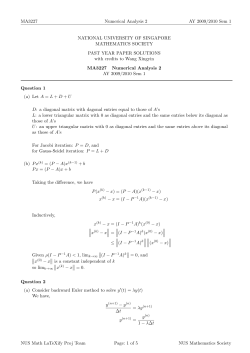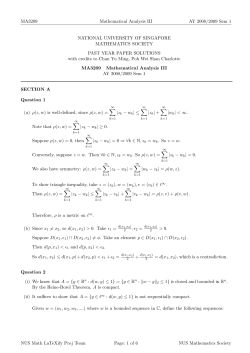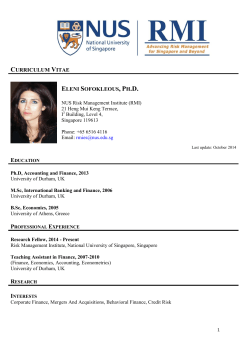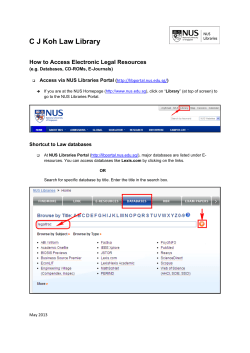
MA2101 Linear Algebra II AY 2012/2013 Sem 2 NATIONAL UNIVERSITY OF SINGAPORE
MA2101
Linear Algebra II
AY 2012/2013 Sem 2
NATIONAL UNIVERSITY OF SINGAPORE
MATHEMATICS SOCIETY
PAST YEAR PAPER SOLUTIONS
Written by Chua Hongshen
Audited by Le Hoang Van
MA2101 Linear Algebra II
AY 2012/2013 Sem 2
Question 1
(a) For any A, A0 ∈ W , k ∈ R, (A + kA0 )u = Au + kAu = 0 ∈ W .
∴ W is a subspace of V .
(b) For any
a b
c d
∈ W , we have
0
1
a b
⇒ a = b, c = d
=
0
−1
c d
0 0
1 1
is linearly independent.
,
Clearly
1 1
0 0
n 1 1 0 0 o
and dim(W ) = 2.
,
∴ A basis for W is
1 1
0 0
n 1 1 0 0 0 1 0 0 o
n 1 1 0 0 o
for V .
,
,
,
to a basis
,
(c) Extend
0 1
0 0
1 1
0 0
1 1
0 0
n 0 1
0 0 o
, then V = W ⊕ W 0 .
,
Let W 0 =
0 1
0 0
Question 2
(a) For any a + bx + cx2 ∈ Ker(T ), we have
1 i 1
a
0
a
−2
0 1 i b = 0 ⇒ b = t −i for some t ∈ C
1 2i 0
c
0
c
1
∴ {−2 − ix + x2 } is a basis for Ker(T ).
∴ nullity(T ) = dim(Ker(T )) = 1, rank(T ) = dim (P2 (C))− nullity(T ) = 2.
(b) From [T ]E,B
1 i 1
= 0 1 i , we have
1 2i 0
T (1) = (1, 0, 1), T (x) = (i, 1, 2i), T (x2 ) = (1, i, 0)
NUS Math LaTeXify Proj Team
Page: 1 of 6
NUS Mathematics Society
MA2101
Linear Algebra II
AY 2012/2013 Sem 2
∴
[T ]E,C = [(1, 0, 1)]E [(i, 1, 2i)]E [(1, i, 0)]E
1 0 2
= 0 i i
1 −1 1
(c) Let P = [I]B,C = [1]B [1 + ix]B [1 + x2 ]B
1 1 1
= 0 i 0.
0 0 1
Then P is invertible and [T ]E,B P = [T ]E,C .
Question 3
(a) Let E = {E11 , E12 , E21 , E22 } be the standard basis for V = M2×2 (R).
Then
0
1
[T ]E =
0
0
1
0
0
0
0 1
0 0
3 −1
2 0
x −1
0
−1
−1 x
0
0 4
3
2
Thus, cT (x) = = x − 3x + x + 3x − 2.
0
0
x
−
3
1
0
0
−2
x
(b) By Cayley-Hamilton Theorem,
T 4 − 3T 3 + T 2 + 3T − 2IV = 0V
1 4
T − 3T 3 + T 2 + 3T = IV
2
1
T ◦ ( (T 3 − 3T 2 + T + 3IV )) = IV
2
Let p(x) = 12 (x3 − 3x2 + x + 3), then T −1 = p(T ).
(c) For any
a b
c d
∈ E1 (T ), we have
−1 1 0 1
a
0
a
1
b
1
1 −1 0 0 b 0
= ⇒ = t for some t ∈ R
0
c
0
0 2 −1 c 0
0
0 2 −1
d
0
d
0
∴ dimE1 (T ) = 1.
NUS Math LaTeXify Proj Team
Page: 2 of 6
NUS Mathematics Society
MA2101
Linear Algebra II
AY 2012/2013 Sem 2
Since cT (x) = (x − 1)2 (x + 1)(x − 2) and dim(E1 (T )) = 1, so the Jordan canonical form of T is
similar to
1 1 0 0
0 1 0 0
0 0 −1 0
0 0 0 2
Question 4
0 1
(a) An example is
.
−1 0
∗ ∗ 0 1
0 1
1 0
0 1
0 1
By direct calculation,
=
=
−1 0
−1 0
0 1
−1 0
−1 0
(b) Since A is normal, A is unitary diagonalizable.
Hence, there exists a unitary matrix P such that
λ1
0
∗
..
P∗ AP =
= Q ⇒ A = PQP
.
0
λn
where λ1 , ..., λn are the eigenvalues of A.
∴
AT = A∗ = (PQP∗ )∗ = P∗ Q∗ P = P∗ QP = A
i.e. A is symmetric.
(c) Let T be a normal operator on a finite dimensional real innner product space. If the characteristic
polynomial of T can be factorized into linear factor over R, then T is self-adjoint.
Question 5
(a) Let {v1 , v2 , ..., vn } be a basis for Ker(S) and{S(w1 ), S(w2 ), ..., S(wn )} be a basis for R(S).
Define B = {w1 , w2 , ..., wm , v1 , v2 , ..., vn } which is a basis for V .
Extend {S(w1 ),S(w2 ), ..., S(w
n )} to a basis of C = {S(w1 ), S(w2 ), ..., S(wn ), u1 , u2 , ..., un } for V .
Im
0m×n
Then [S]C,B =
.
0n×m 0n×n
W 0m×n
(b) [T ◦ S]B =
.
Y 0n×n
W
X
[S ◦ T ]B =
.
0n×m 0n×n
NUS Math LaTeXify Proj Team
Page: 3 of 6
NUS Mathematics Society
MA2101
Linear Algebra II
AY 2012/2013 Sem 2
(c)
xIm − W 0m×n = det(xIm − W)det(xIn ) = xn cW (x).
cT ◦S (x) = −Y
xIn xIm − W −X
= det(xIm − W)det(xIn ) = xn cW (x).
cS◦T (x) = 0n×m
xIn ∴ cT ◦S (x) = cS◦T (x).
(d) No.
For example, let S and T be linear operator on R2 such that
S((x, y)) = (x, 0) and T ((x, y)) = (y, 0) for (x, y) ∈ R2
Then,
(T ◦ S)((x, y)) = T (S((x, y))) = T ((x, 0)) = (0, 0) for (x, y) ∈ R2 .
So T ◦ S is the zero operator on R2 and hence mT ◦S = x.
On the other hand,
(S ◦ T )((x, y)) = S(T ((x, y))) = S((0, y)) = (y, 0) for (x, y) ∈ R2 .
2
Let E = {(1, 0), (0,
a basis for R .
1)} be
0 1
and hence mS◦T = x2 .
Then [S ◦ T ]B =
0 0
T ◦ S and S ◦ T do not have the same minimal polynomial.
Question 6
(a) (i) u ∈ Ki ⇒ Qi (u) = 0 ⇒ Qi+1 (u) = Q(Qi (u)) = Q(0) = 0 ⇒ u ∈ Ki+1 .
∴ Ki ⊆ Ki+1 .
(ii) We prove by induction that Km = Km+1 , ∀m ≥ k, which implies Kk = Km , ∀m ≥ k.
Given that Kk = Kk+1 . Suppose that, Km = Km+1 where m ≥ k.
For any u ∈ Km+2 , we have
Qm+2 (u) = 0 ⇒ Qm+1 (Q(u)) = 0 ⇒ Q(u) ∈ Km+1 = Km
Then Qm+1 (u) = Qm (Q(u)) = 0 and hence u ∈ Km+1 .
So, we have shown that Km+2 ⊆ Km+1 and together with Km+1 ⊆ Km+2 from part (i), we have
Km+1 = Km+2 .
Thus, by Mathematical Induction, Km = Km+1 , ∀m ≥ k.
NUS Math LaTeXify Proj Team
Page: 4 of 6
NUS Mathematics Society
MA2101
Linear Algebra II
AY 2012/2013 Sem 2
(b) (i) Suppose u ∈ K ∩ R, i.e. Qs (u) = 0 and u = Qs (v) for some u ∈ V .
Then Q2s (v) = Qs (u) = 0 and hence v) ∈ K2s = Ks = K. This means u = Qs (v) = 0.
So, we have K ∩ R = {0} which implies that K + R is a direct sum.
By the Dimension Theorem for linear transformation,
dim(V ) = dim(K) + dim(R) = dim(K ⊕ R)
As K ⊕ R ⊆ V , we have V = K ⊕ R.
(ii) For all u ∈ K,
(T |K − λIK )s (u) = (T − λIV )s (u) = Qs (u) = 0
i.e. (T |K − λIK )s = 0K and hence mT |K (x)|(x − λ)s ⇒ mT |K (x) = (x − λ)t for some t ≤ s.
Assume that t < s. Since Kt $ Ks , there exists v ∈ Ks − Kt . Then
(T |K − λIK )t (v) = (T − λIV )t (v) = Qt (v) 6= 0
which contradicts with the fact that (T − λIV )t (v) = 0K .
∴ mT |K (x) = (x − λ)s .
Question 7
(a) Take any u ∈ Ker(T ). Then
T (u) = 0 ⇒ (T ∗ ◦ T )(u) = T ∗ (T (u)) = T ∗ (0) = 0 ⇒ u ∈ Ker(T ∗ ◦ T ).
∴ Ker(T ) ⊆ Ker(T ∗ ◦ T ).
Take any v ∈ Ker(T ∗ ◦ T ). Then
hT (v), T (v)i = hv, T ∗ (T (v))i = hv, (T ∗ ◦ T )(v))i = hv, 0i = 0
⇒T (v) = 0
⇒v ∈ Ker(T )
∴ Ker(T ∗ ◦ T ) ⊆ Ker(T ).
Thus, we have Ker(T ∗ ◦ T ) = Ker(T ).
(b) No, for example, let T be a linear operator on R2 such that
x
0 1
x
x
T
=
for
∈ R2
y
0 0
y
y
Then Ker (T ) = span {(1, 0)T } while Ker (T ∗ ◦ T ) = span {(0, 1)T }.
NUS Math LaTeXify Proj Team
Page: 5 of 6
NUS Mathematics Society
MA2101
Linear Algebra II
AY 2012/2013 Sem 2
(c)
T (u) is the orthogonal projection of b onto R(T )
⇐⇒ b − T (u) is orthogonal to R(T )
⇐⇒ hT (v), b − T (u)i = 0 for all v ∈ V
⇐⇒ hv, T ∗ (b) − (T ∗ ◦ T )(u)i = 0 for all v ∈ V
⇐⇒ T ∗ (b) − (T ∗ ◦ T )(u) = 0
⇐⇒ T ∗ (b) = (T ∗ ◦ T )(u)
⇐⇒ x = u is a solution to T ∗ (b) = (T ∗ ◦ T )(u)
(d) Take any w ∈ {u|T (u) = b}. Then,
(T ∗ ◦ T )(w) = T ∗ (T (w)) = T ∗ (b)
i.e. w ∈ {u|(T ∗ ◦ T )(u) = b}.
∴ {u|T (u) = b} ⊆ {u|(T ∗ ◦ T )(u) = b}.
Take any w0 ∈ {u|(T ∗ ◦T )(u) = b}. Since (T ∗ ◦T )(w) = T ∗ (b), by part (c), T (w0 ) is the orthogonal
projection of b onto R(T ).
As b ∈ R(T ), the orthogonal projection is b itself, i.e. T (w0 ) = b and hence w0 ∈ {u|T (u) = b}.
∴ {u|(T ∗ ◦ T )(u) = b} ⊆ {u|T (u) = b}.
Combining both, we have {u|T (u) = b} = {u|(T ∗ ◦ T )(u) = b}.
NUS Math LaTeXify Proj Team
Page: 6 of 6
NUS Mathematics Society
© Copyright 2025


















